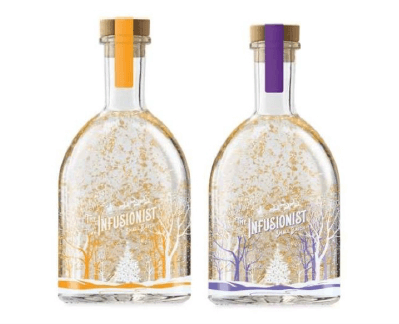
Not-so-bright result for Aldi in UK registered design infringement appeal
In the autumn of 2020, M&S launched a festive gin-liqueur, packaged in a bottle depicting a winter scene. An LED light at the base illuminated gold flakes suspended in the liquid when the bottle was shaken. M&S registered design rights in the bottle design. The following Christmas, Aldi released its ‘Infusionist’ range of gin-liqueur, which was sold in a similarly shaped bottle containing a winter scene, an LED light and gold flakes suspended in the liqueur.
M&S sued Aldi for infringing its registered designs and was successful at first instance (see our earlier article here). Aldi appealed to the Court of Appeal.
M&S’s registrations

Aldi’s Infusionist range

The scope of M&S’s design protection
One of the key questions for the Court of Appeal was whether the LED light at the base of the bottle formed part of M&S’s registered designs. The judge at first instance held that it did, but only in the case of the two registrations depicting the bottle in front of a dark background, as these were the designs where the illuminating effect of the light was most obvious.
On appeal, Aldi argued that these two registrations depicted a bottle with dark-coloured glass and/or dark liquid.
The Court of Appeal dismissed Aldi’s argument, highlighting the following features from the design representations:
- The glass towards the top of the neck of the bottle is clear;
- There is no gap between the top of the liquid and the bottle stopper, as there would be if the liquid was dark; and
- The winter scene is vibrantly clear, which would not be the case if the glass and/or liquid was dark.
The Court of Appeal also overturned the first instance decision that the two designs depicting the bottle against a light background did not include the LED light on the basis that:
- The images on M&S’s registrations do show features of the bottle being illuminated;
- The court can inspect the physical product to confirm conclusions already drawn from design registrations (following the Court of Justice in PepsiCo v Grupo Promer Mon Graphic).
- The ‘indication of product’ on design registrations can be used to resolve ambiguity as to what is shown in the design representation – much like a user consulting the design register would do. In this case, M&S’s registrations referred to a ‘light up gin bottle’.
Grace period
Designs must be novel and have individual character within the existing design corpus to be registrable. Proprietors are given a 12-month grace period from first disclosing a design to register it. Therefore, disclosures by the designer during the grace period are disregarded when assessing the novelty and individual character of a design.
M&S had disclosed several similar bottle designs during the 12-month grace period preceding registration of the designs in dispute. Aldi argued the judge had been wrong to disregard these disclosures when considering the scope of the design corpus, which informed the assessment of whether Aldi’s bottles created the same overall impression as (i.e. infringed) M&S’ designs, as there is no statutory provision for disregarding disclosures during the grace period, as there is for assessing novelty/individual character. The Court of Appeal dismissed this argument on the basis that such an approach would substantially defeat the purpose of the grace period.
The court noted that not all disclosures by the designer should be disregarded; just those that cover an identical design or those that do not create a different overall impression to the design registration that subsequently follows. Therefore, designers that disclose a number of distinct designs in the process of test marketing products risk limiting the scope of protection afforded by the final registered design.
Lights on for registered design protection
The result in this appeal was perhaps unsurprising, however, it is useful confirmation as to the correct interpretation of the Registered Designs Act in relation to disclosures during the grace period when considering the relevant prior art. The Court of Appeal also provided further helpful guidance on interpreting registered designs, which can include looking at the “indication of product” on the registration and the physical product itself.
The case is also a useful reminder of the value of registered designs in tackling copycat products.
The Court of Appeal’s judgment can be found here.








